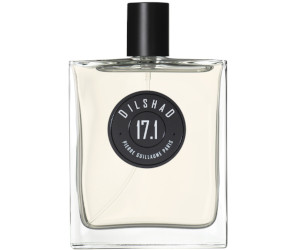
French niche line Pierre Guillaume has introduced 17.1 Dilshad, a new tuberose fragrance. Dilshad is the second fragrance in the series that started with 17 Tubéreuse Couture.
THE INSPIRATION Tubéreuse Couture 17: a killer in majesty. Pierre GUILLAUME’s first approach can be seen as an anatomical study of the flower: a surgical dissection of its fundamental olfactory facets, whose formula has no other aim than to tell the story of and glorify tuberose from the top to the base notes. Tuberose is the star and sole protagonist of a tailor-made scenario. In this new opus, the tuberose is put at the service of a story and shares the stage with a young leading lady…
THE FRAGRANCE A pistachio and tuberose accord. The complexity of tuberose and its voluptuous strangeness make it a difficult beauty to marry. When macho accords of animalised leathers don’t try to silence it, we surround it with stooges. Jasmine and orange blossom often play “diplomatic supporting roles”. It’s in pistachio that Pierre GUILLAUME has found an alter ego who can match the floral Diva blow for blow. The bitterness and green notes that naturally resonate within them create the link cultivated by the perfumer. The tuberose flowers seem to infuse a bath of musk and almond milk, a delicate evocation of the enfleurage technique.
THE NAME DILSHAD means “The one who brings happiness” in Persian, a reference to the Iranian pistachio.
Additional notes include opopanax.
Pierre Guillaume Dilshad is available in 50 and 100 ml Eau de Parfum.
(via pierreguillaumeparis, found via bloomperfume.co.uk)
Hi Robin and everyone. I’m chiming in for the first time in a while, ‘
As fan of so many PG creations, I own Tubéreuse Couture though I wear it rarely. It’s a loud and fairly camphoraceous powerhouse, but I love the sugar cane note. I’d be curious to smell this riff on it.
Very coincidentally, I was just this morning reading again about the pistachio shrub, Pistacia lentiscus, which is probably the “pistachio” mentioned here (and not the common edible nut that comes from sibling ‘Pistacia vera’). Also known as mastic/mastik, or “lentisque” in French, and the source of mastic gum/resin, it grows widely around the Mediterranean. (I was reading about it because I just gleefully snagged a bottle of long-discontinued favorite from 2007: Lentisque by Parfums 06130.)
Have a great week! I still stop in from time to time though only rarely comment. But this has long been a treasured space for information and commentary—my first perfume hobbyist ‘home base.’
Edit: Maybe this fragrance does actually refer to the pistachio nut and not its mastic cousin, as I now see the reference to the name being derived from the Iranian pistachio (Pistacia vera).
Thanks for both notes, very helpful and interesting. I’m not at all persuaded that pistachio is some kind of good complement to tuberose. Hmmm.
Hmm. My mind went from pistachios to pistachio halva, and that did not link up successfully in my imagination with any facet of tuberose… I would like to sniff it if I ever have a chance…
Hey Joe, so nice to see you!
I’ll probably get a sample. It makes me think of some of the stuff he used to do that I loved, that initial set of numbered fragrances.
I am so behind…I don’t think I have tried a single one of the variations on a theme he’s been doing the past few years.
I tried a sample. Tuberoses and pistachios work very well. But it’s a copy of praline de Santal another fragrance by Pierre Guillaume.
BTW it’s very good
Thanks Luca!